- Home
- Rudy Rucker
The Hacker and the Ants Page 2
The Hacker and the Ants Read online
Page 2
Each of the simmies in the Roarworld program had a bunch of software stubs to which the user could attach his/her own pieces of code, thus tailoring the Roarworld simmies’ appearance and behavior. If you preferred it, you could have the Roarworld creatures look like lions and tigers, or sharks and dolphins, but to my mind the dinosaur graphics were by far the best. To make the simulation livelier, I’d linked the dinosaurs’ legs to copies of Studly’s control-feedback walking algorithms. My dinosaurs chased after each other really well. When I toggled on the mighty Roarworld sound module, it was more than awesome. GAH-ROOOOONT!
My virtual desk had a simmie keyboard and a mound of flat simmies of sheets of paper: letters and programs I was currently working on. If I wanted to revise a document, I just picked up its simmie, positioned it over the virtual keyboard, and typed away. My simmie keyboard was so sensitively tuned to my glove outputs that I only needed to wiggle the tips of my fingers.
When I was typing, an outside observer would have seen me madly twitching my fingers in the air. I’d gotten rid of my mechanical keyboard because I’d reconfigured my simmie keyboard to the point where it didn’t closely match the dumbly obstinate geometry of the mechanical board.
Even though I typed in thin air, it felt as though I was touching something, for my gloves had tactile feedback. Woven in with the Spandex were special piezoplastic touchpads that could swell up and press against my hand. The touchpads on my fingertips pulsed each time I pushed down on a virtual key.
It was marvelous, but sometimes my hands missed the physical support of a keyboard. When I would hack a lot, my forearms would hurt and my thumbs and pinkies would get numb. I sometimes worried about getting carpal tunnel syndrome and losing my ability to type. For a hacker this would be like a trumpeter losing his or her lips. I kept meaning to get a wedge of malleable plastic in the shape of a keyboard. It was easy to get them, like at Fry’s Electronics in Sunnyvale; they were called feely-blank keyboards.
You could get all sorts of feely-blank accessories for cyberspace, and yes, dear horn-dog, there were even male/female feely-blank love-dolls, complete with hinged limbs and cunningly engineered touchpads. The love-dolls came with get-down simmie software to show images that matched the doll’s motions. If you wanted to spend a little more money, you could go to a porno web site for a live person who’d puppeteer your doll through all manner of erotic outrages. But I hadn’t looked extensively into the details of cybersex; when you were hacking as much as I did, you didn’t want to be near a computer in your free time.
The two feely-blank things I actually owned were a potter’s wheel and a weighted golf club handle which Carol had given me last Christmas. The club handle was short—so that I didn’t smash everything around me while working my way down, say, the fabulous second oceanside hole of the Toshiba Cyberspace Pebble Beach. The clever thing about the feely-blank golf club was that the tip held a gyroscope which did a cyberized jiggly-doo right when I would hit the virtual ball—giving me the shock of contact.
The potter’s wheel was for Carol, and for awhile she had enjoyed using it. It was like a regular electric wheel, except that it had a permanent “lump of clay” which was made of firm, malleable titaniplast putty. They used the same stuff for the feely-blank keyboards; you could mold and remold it to any shape you wanted, and it never got brittle. I’d kept all the virtual pots Carol made in a file somewhere.
Anyway, I kept meaning to go get a fake keyboard, but physically going places and buying material objects for my computer was not something I was into. I mean walking into a place like Fry’s Electronics was always a downer, everyone sucking down Jolt Colas and munching candy bars, no women in sight, just males—pitiful bewildered larvae from under a rock, or pompous bearded lawn-dwarves with tenor voices, or square-forehead Frankenstein monsters, or sweaty strivers with no fingernails—lumps and losers to a man. How had I ended up associated with this class of people? Oh well, as the California kids would say when something not particularly desirable happened. Oh well!
The two neatest things in my virtual office were my Lorenz attractor and my dollhouse. The Lorenz attractor was a floating dynamical system consisting of orbiting three-dimensional icons, little simmie images that represented pieces of information and the various things my computer could do. The icons tumbled along taffy trajectories that knotted into a roller coaster pair of floppy ears with a chaotic, figure eight intersection. If I liked, I could make myself small and ride around on the Lorenz attractor in a painless demolition derby with my files. It was a fun way to mull things over.
My dollhouse was a special miniature cyberspace model of my house that I’d once made as a Christmas present for little Ida. She’d never actually played with it that much—one reason being that I was hardly ever willing to let anyone else use my gloves and headset. I needed them all the time for all the work I had to do—always too much work!
I’d tweaked my real house’s alarm system so that if anyone touched a door or window, the corresponding door or window would light up on the dollhouse. I had little models of myself and my family members inside my dollhouse. Actually my wife and three children shouldn’t have been in the dollhouse at all anymore, as they no longer lived here, but it would have made me too sad and lonely to erase them. In my dollhouse, my wife was in the kitchen and my kids were lying on their stomachs in the living room doing homework and watching a tiny digital TV. If they’d actually been in my house, moving from room to room, the little simmie-dolls that represented them would have moved around too. My house was smart enough always to know who was in which room. The little virtual TV was hooked into the Fibernet system; sometimes I would make myself small and watch it with my dolls, though never for long. Everything on TV enraged me, because everything on TV was the same: the ads, the news, the shows. In my opinion, all TV was all part of the huge lying Spectacle that the government kept running to oppress us all. Digital data compression had brought us a thousand channels, but they all sucked, same as ever.
The dollhouse’s Studly-model did move around because he actually was physically in the house with me, rolling around and cleaning, gardening, keeping an eye on things, taking care of business, and occasionally talking to me. If I wanted to check something in the house, I could switch over to Studly’s viewpoint, and see what he was seeing through his two video camera eyes. When Carol had still lived with me, I would sometimes use Studly to sneak in and watch her while she was dressing or taking a piss. That would drive her frantic with rage. “I know you’re in there, Jerzy,” she’d scream as oily Studly sidled up to capture her pixels and send them through the aether to me. “Get your head out of that computer and come talk to me like a human being!” Usually, however, I didn’t have the time. When I was programming, I was always in a terrific rush.
Sitting in my office after Susan Poker left, it occurred to me that if I were to use Studly to kill the Realtor, I wouldn’t really have to program him for it. It would be much easier to couple myself to his manipulators and drive him in real time. That was known as telerobotics—a person driving a robot that was somewhere else, with the distant person using television to “see through the eyes of the robot.” Telerobotics was one of the most fun things you could do with a robot.
Tunelessly humming, I looked up from the dollhouse and stared at the images riding my Lorenz attractor. Most of them were quite familiar, but what with my hookup to the Net and the existence of some more or less autonomous processes in our company machines, I would sometimes spot a new icon. Today the new one was a little 3-D image of an ant, a sweetly made photo-realistic model with mandibles, head, antennae, alitrunk, legs, petiole, and gaster—the spitting image of the virtual ants that Roger Coolidge had been working on in his lab at GoMotion. But no way were any GoMotion ants supposed to be loose like this. I pincered it up with virtual thumb and forefinger. It wriggled its legs and turned its head to bite me. The ant bite made a tingling physical flutter in my glove’s touchpads. There was a noise with it,
a double burst of skritchy chaos. I dropped the ant. Chirping angrily, it dug its way down through my virtual office floor and disappeared.
Instead of chasing after the ant, I pointed my finger to the GoMotion door and nodded in there. The necessary information traveled over the Fibernet and then for a moment I saw nothing but a snowstorm of static, as the GoMotion communication software checked my access codes. There was a warbling tone as our systems synced together, and then I walked into the virtual offices of GoMotion.
How did I look? Like most users, I owned a tailor-made simmie of my cyberspace body. Cyberspace users called their body-simmies tuxedos. My tuxedo was a suite of video images bitmapped onto a blank humanoid form. The form’s surface was a mesh of triangles which could be adjusted like a dressmaker’s dummy; and inside the form were virtual armatures and hinges so that the thing moved about as realistically as one of those little wooden mannequins that artists used to have. The overall size of the thing was adjusted to closely match my body size with, of course, a few inches taken off the waist.
I’d had my body surfaces taped by a professional body-mapping studio right there in Los Perros: Dirk Blanda’s Personography. You’d go to Dirk Blanda’s and in the reception area there was a wall with plaster body-shapes lined up against it. Mounted on the ceiling over each body was a video projector beaming a satisfied customer’s image onto one of the body-shaped screens. Dirk Blanda’s had started out as a photo studio, but when the last big quake had wiped out his building, he’d retooled and gotten modern. I actually knew Dirk fairly well as his house was almost next to mine.
The tuxedo I used was pretty routine; it showed me wearing what I usually wore in real life, which was sandals, patterned socks, shorts, and a California sport shirt. I could change the patterns of the fabrics of my socks and shirt, and if I wanted to, I could get new simmie clothes, or I could even turn my clothes off entirely. The nude version of my tuxedo allowed me the option of deciding whether or not my simmie-genitals should show. In any case, the face was the important part. I had a series of canned expression shots; Dirk’s assistant had spent the better part of two hours coaching me into convincing expressions of laughter, surprise, boredom, anger, grief, etc. For casual communication, my software would guess at my expression from the sound of my voice. For higher-bandwidth communication, there was a pencil-sized video camera on my computer which could map real-time images of my face onto my tuxedo’s head.
I came into the GoMotion reception area wearing an expression of controlled worry. The tuxedo of Leonard, the tech group secretary, looked up at me and activated a roguish-smile expression. Leonard had a damp mustache and a perpetual sunburn. His virtual office was a big loft with clean white walls and skylights showing fluffy clouds overhead. A simmie of Bengt, our virtual prototype for Studly’s successor, was purring back and forth, pushing a polisher across the parquet floor. Bengt’s neck was a bit longer than Studly’s, and his body box had a slimmer shape. But for his legs he used the same inspired wheels-on-legs hack as Studly.
“Hi, Jerzy,” said Leonard.
“Hi, Leonard. Say, I think some of our ants got loose. Has anyone else noticed?”
Leonard laughed merrily. In his tux laugh loop, he would always touch his tongue to his mustache at the right corner of his mouth, a tic which made him seem both puppyish and devil-may-care.
“Why don’t you ask your bad rogue ant for some ID? Dereference a pointer or something.”
“When I picked it up, it bit me,” I explained. Leonard laughed the more wildly.
“It’s not funny, Leonard. If the ant is eating and shitting and leaving trails, all my code is being corrupted. It’s a wonder I can still see.”
“I’d think you’d be proud of yourself. Roger’s been promising us live ants for years, and now that you’ve been working with him, one of his ants has finally gotten smart enough to break out. Isn’t that a good thing, Jerzy?”
“Is Roger here?”
“He’s been in and out all weekend. Maybe he e-mailed you the ant!”
“Maybe.” Sending an experimental artificial life-form as an e-mail attachment would be an incredibly careless thing to do, but not wholly out of character for Roger Coolidge. He was a genius-level computer hacker, somewhat eccentric, and imbued with the self-confidence that came from having founded a Silicon Valley startup that had mushroomed to a billion dollars in revenue in six short years. It was an honor for me to get to work so closely with him. Sometimes it was also a pain in the neck.
I sighed, and my computer transmitted my sigh from my microphone to Leonard’s receiver, wherever Leonard really was. Often he was physically at the GoMotion office in Sunnyvale, but several days a week he worked from his apartment down on Market Street in San Francisco. Maybe instead of wearing the gloves and the headset, he was watching me on a digital TV set, talking to me over a telephone, and moving his simmie with a video game joystick. For all I knew, looking at Leonard’s brightly cheerful cyberspace simulacrum, he was spending the day in bed with a lover. It was no use speculating. “How’s Bengt been doing? Has he banged into the furniture?”
“No. He’s smarter than Studly. Look.” Leonard scooped a handful of paper clips off his desk and threw them out in front of Bengt. GoMotion had modeled the laws of physics into Leonard’s office, so the little paper clip simmies flew along naturalistic parabolas, bounced on the woodgrain-patterned floor, and skidded to rest.
Bengt had been down on all four wheels pushing his floor buffer, but now he rose up into an alert crouch, balancing easily on his flexed legs. After carefully looking around the room, Bengt wheeled over to stop a few inches from the nearest paper clip and unfolded his pincer-clamp manipulator. Delicately he tweezered up the paper clip and put it in a drawer in his chest. Moving with no wasted motions, Bengt worked his way around the room to pick up all the paper clips before he resumed buffing the floor. The less efficient Studly would have dealt with the paper clips in a one-by-one piecemeal fashion as his floor polisher bumped into them.
“Right on,” I said. “The improvements are thanks to genetic algorithms and artificial life, Leonard. I think Bengt’s ready for Our American Home.”
After one of our personal robot models could negotiate Leonard’s virtual office, we liked to test it in a full-size simmie-house that we called Our American Home. We had simmies of a family who supposedly lived there: clumsy Walt and Perky Pat Christensen, with son Dexter and daughter Baby Scooter. They all had blond hair and texture-mapped tan skin, and they all bothered the robots in different ways.
Dexter liked to play pranks. He’d tip a robot over onto its back and drag it to the head of the stairs with a blanket over its head. Perky Pat would give the robots contradictory commands, “Now follow me, and stay right where you are. Hurry, dammit!” Baby Scooter was a sullen blob who would nap on the floor, waiting to see if a robot would bump her or nip her so she could scream bloody murder. Sometimes Walt got “drunk,” and Perky Pat got “totally wired,” and they would lurch and spazz around, doing their best to trip over the increasingly wary robot simmie.
The tests in Our American Home were crucial, as the possibility of personal robots injuring someone was the A-number-one factor that had kept them off the open market in the past. Although if there were accidents, GoMotion’s position would be that they were only selling kits and software for the Veep robots—rather than the completed Veeps themselves. If your robot screwed up, it was your fault for having built it. So far this type of defense had held up against people whose Iron Camels had crashed. Our kits came with “no explicit or implied warranty of merchantibility or fitness for a particular purpose.” Even so, the Veeps had to be very safe and very good if they were going to sell well.
My work at GoMotion was to try and use artificial life evolution techniques to improve the programs that controlled the Veep. Once we had the specs for a new prototype, instead of actually building it out of wires and metal, we would generate a simmie of the thing and test it out in
cyberspace. Roger Coolidge had been one of the first fully to exploit this great corner-cutting trick. He had used it to design the Iron Camel. Being something of a bullshit artist, in the most Midwestern kind of way, Roger had dubbed his trick “cybercad.”
CAD stood for computer aided design; most architects and engineers were using CAD instead of drafting tools. The idea behind CAD was to draw a three-dimensional computer graphics model of, say, a fan blade before you built it. Someone gave you a blueprint for a fan blade and you made a digital data base which in some sense was the blade. You could generate graphic views of it from every angle, zoom in on its details, take cross sections of it, calculate its weight and volume, etc. Cybercad meant pushing all this a little farther; in cybercad you could pump in virtual air, spin the blade, and measure the net blowage.
The funny thing about the “cyber” prefix was that it had always meant bullshit.
Back in the 1940s, the story went, MIT doubledome Norbert Wiener had wanted a title for a book he’d written about the electronic control of machines. Claude Shannon, also known as The Father Of Information Theory, told Wiener to call his book Cybernetics. The academic justification for the word was that the “cyber” root came from the Greek word for “rudder.” A “kyber-netes” was a steersman, or, by extension, a mechanical governor such as a weight-and-pulley feedback device you might hook to your tiller to keep your sailboat aimed at some fixed angle into the wind. The practical justification for the word was contained in Shannon’s advice to Wiener: “Use the word ‘cybernetics,’ Norbert, because nobody knows what it means. This will always put you at an advantage in arguments.”

 Million Mile Road Trip
Million Mile Road Trip Good Night, Moon
Good Night, Moon Transreal Trilogy: Secret of Life, White Light, Saucer Wisdom
Transreal Trilogy: Secret of Life, White Light, Saucer Wisdom Complete Stories
Complete Stories The Sex Sphere
The Sex Sphere Surfing the Gnarl
Surfing the Gnarl Software
Software Mathematicians in Love
Mathematicians in Love Seek!: Selected Nonfiction
Seek!: Selected Nonfiction The Secret of Life
The Secret of Life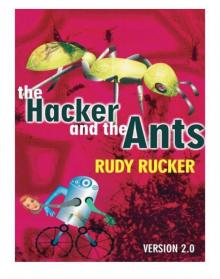 The Hacker and the Ants
The Hacker and the Ants Postsingular
Postsingular Spaceland
Spaceland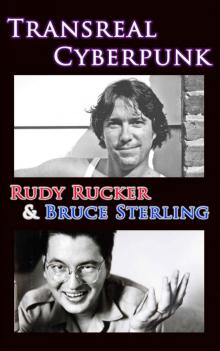 Transreal Cyberpunk
Transreal Cyberpunk Sex Sphere
Sex Sphere Spacetime Donuts
Spacetime Donuts Freeware
Freeware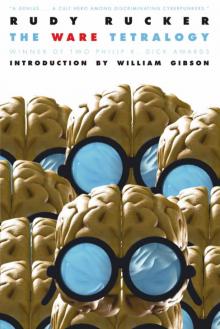 The Ware Tetralogy
The Ware Tetralogy Frek and the Elixir
Frek and the Elixir Junk DNA
Junk DNA White Light (Axoplasm Books)
White Light (Axoplasm Books) Nested Scrolls
Nested Scrolls Inside Out
Inside Out Where the Lost Things Are
Where the Lost Things Are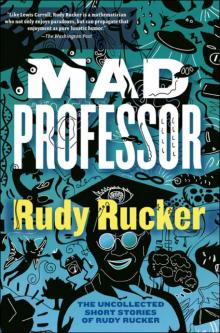 Mad Professor
Mad Professor As Above, So Below
As Above, So Below Realware
Realware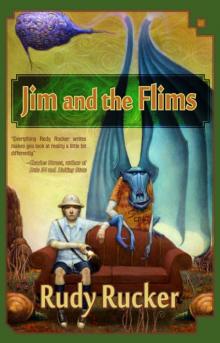 Jim and the Flims
Jim and the Flims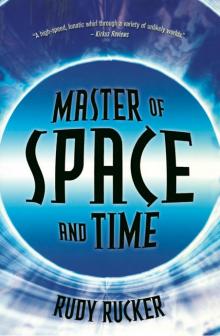 Master of Space and Time
Master of Space and Time The Big Aha
The Big Aha Hylozoic
Hylozoic